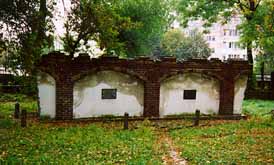New Cemetery in Lublin
Of the four Jewish cemeteries in Lublin
before the war, only two are still in existence: the New Cemetery
on Walecznych Street which was opened in 1829, and the Old Cemetery.
The Old Cemetery dates back to the first half of the 16th century
and is the oldest historical Jewish monument in Lublin.
During the Nazi occupation, all but a
few of the grave stones in the New Cemetery were destroyed. One
that was spared and has been restored is the monument of the
famous rabbi of Lublin, Yehuda Meir Szapiro, who died in 1933.
He was the founder and rector of the Yeshiva Chachmei Lublin
in 1930. In 1958, his remains were taken from the destroyed New
Cemetery and interred at the Har Ha-Menuchot cemetery in Jerusalem.
His monument or ohel is still at the New Cemetery in Lublin.
The large monument, shown in the photograph
below, is the ohel of Rabbi Szapiro, which was unveiled on Nov.
9, 1987 on the 45th anniversary of the liquidation of the Lublin
ghetto.
 Monument to Rabbi Szapiro
Monument to Rabbi Szapiro
Like most Jewish cemeteries in Poland,
those in Lublin were desecrated by the Nazis who removed the
tombstones and used them to pave the paths at the Majdanek concentration
camp. The cemetery in the Wieniawa Jewish quarter was completely
destroyed, and all but 100 of the tombstones in the Old Cemetery.
The Jewish Military Cemetery, dating back to 1918, was also completely
demolished. Pictured above is the New Cemetery with contemporary
graves from the post-war period.
The photo below shows a common grave
of Jews murdered by the Nazis in Lublin.
 Common grave in New
Cemetery in Lublin
Common grave in New
Cemetery in Lublin
The photo below shows a section of the
old wall which survived the Nazi destruction of the cemetery.
In front of it is another common grave of Jewish victims of the
Nazis.
 Remnant of old wall
marks common grave
Remnant of old wall
marks common grave
|